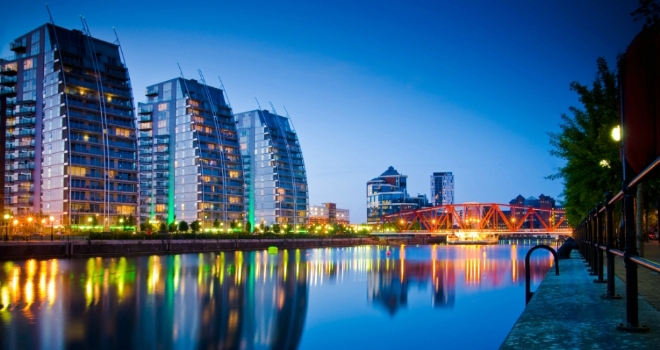
ZPG listings data shows discounts to asking prices are narrowing, indicating market conditions are improving across cities outside south eastern England. Increased discounting can be seen in London, where price growth has slowed to +1.8%.
City house price growth running at 5%
UK city house price inflation is running at 5%, up from 4% a year ago. Edinburgh is the fastest growing city (+7.7%) with Birmingham, Manchester, Leicester and Liverpool all growing by more than 6% per annum.
Prices falling in real terms across five cities
There are five cities where house prices are falling in real terms – Southampton, London, Oxford plus two where prices are falling in nominal terms – Cambridge (-1.1%) and Aberdeen (-6.6%).
Price growth since 2009 ranges from +6% to +86%
The level of house price inflation since the end of the downturn in 2009 varies widely. Fig. 2 shows that growth ranges from 6% in Aberdeen to 86% in London. Oxford and Cambridge have performed like extensions of London, while robust price growth in Bristol has resulted in a 70% increase since 2009.
There is a clear gap to the remaining cities, each of which have experienced varied growth. These differentials are explained by economic and demand side factors. A similar pattern of relative performance was seen mid-way through the last housing cycle.
Timing and scale of growth varies over time
Over housing cycles housing markets register different growth rates at different times. By the end of 2013, the strongest growth had been registered in London as overseas and domestic buyers boosted demand.
In contrast, most large regional cities outside southern England failed to record a 10% increase in prices by the end of 2013. Glasgow and Liverpool continued to register price falls at this time. Only in the last 2 years have large regional cities started to record above house price growth on improved consumer confidence, rising employment and attractive affordability metrics.
Will all cities grow as much as London?
Cities outside southern England have further room for house price growth. We do not expect growth to match the increase registered in London as the market dynamics are different e.g. high levels of overseas and investor buying. There are also questions over the sustainability of pricing in London where gross yields are sub 4.5% and affordability levels are at an all time high. We expect average house prices in London to drift lower in real terms in the coming 2-3 years with lower turnover (down 16% since 2014) creating scarcity.
How much further can prices rise in regional cities?
We expect house prices in regional cities such as Birmingham and Manchester to increase by 20% to 30%. This is based on our analysis of how the last housing cycle unfolded and adjusting for today’s policy environment. It assumes mortgage rates remain low by historic standards and the economy to continues to grow. At current growth rates this will take 3 to 4 years to feed through into house prices.
Russell Quirk, founder and CEO of Emoov.co.uk, commented: "Despite the Beast from the East bringing a cold snap weather-wise, demand for city living and resulting house price growth continues to thaw as the discounts required in asking price to secure a sale closes further.
The UK remains a vast and varied landscape in terms of the property market and it is interesting to see how this also relates to the recovery time of each city since the end of the downfall in 2009.
We've seen a modern-day tortoise and the hare tale as those cities, like London, that saw a rapid return in property prices in the more immediate aftermath of the market crash, are now paying the price in slower market conditions.
At the same time, those larger regional cities that have required a much longer recovery period are now pulling away where price growth is concerned and have become a much more attractive proposition for buyers."
Simon Heawood, CEO of Bricklane.com said: “London has seen a fall in the price of prime and super prime properties in areas like Kensington and Chelsea which has principally contributed to a fall in the average house price. The reality is that in the areas and segments of the market where most in the Capital would be able to buy, prices are still rising. In many ways it's a good time to be a buyer, and our London property fund has felt this effect strongly.
Outside London the market looks to be in good health, particularly in key cities like Birmingham where YoY growth was over 6‰ and Hometrack projects the market has a further 20-30‰ to move. Most of the UK's 'gateway' cities boast attractive demographic trends and benefit from significant investment and infrastructure projects. As such they are increasingly attractive as places to work and live, and offer greater prospects than London for home-ownership and investment alike.
If today's report shows anything it is that the structural undersupply of housing persists across the UK, and this will continue to drive pricing: those who can participate stand to benefit. What is needed now are solutions which give everyone the ability to own a stake in the market, no matter how much they can afford, and which give investors the opportunity to rationalise their portfolios. "





